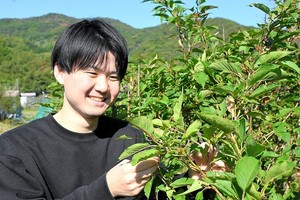By TATSURO SUGIURA/ Staff Writer
July 15, 2023 at 07:00 JST
MAEBASHI, Gunma Prefecture--What to do with “okara,” or soy pulp, a by-product of tofu production, has long vexed tofu makers.
Until now, a large percentage of the pulp was discarded as waste, but a leading company has come up with a solution: “okara pellets” that can be used as a material for processing plastic products.
“It has been a cherished wish among tofu makers to find an effective use for okara,” said Junji Torigoe, president of Sagamiya Foods Co. “We want to spread its use across the entire industry.”
The Maebashi-based company is known for offering tofu products with a cheese-like flavor and texture under its “Beyond Tofu” series.
Sagamiya Foods and its group companies get through about 53,000 tons of soybeans a year.
But tofu production produces the same amount of okara as soybeans used during the process.
While soy pulp is used for human consumption, livestock feed, cat litter and other purposes, one-third of it is tossed as industrial waste.
“Because okara contains a lot of moisture, it easily changes color and gets moldy,” Torigoe said. “Its use is limited, and we have no choice but to discard most of it. It has been a long-standing problem for the industry to find an effective alternative use.”
While Sagamiya Foods was seeking new ways to utilize soy pulp, it took note of biomass plastic made from plant-based materials.
Around five years ago, the company began developing pellets using okara as a key ingredient.
Through trial and error, the tofu maker developed okara pellets this past spring.
Dried soy pulp is ground into fine particles, which are mixed with polypropylene, a type of synthetic resin, to produce the pellets.
Torigoe insisted that the pellets contain 51 percent of okara so they can be classified as “processed soy pulp,” not as “plastic.”
“It is important when it comes to realizing a recycle-based society,” he said. “It is my obsession to maintain the 50-percent target.”
The company is also developing products made from biomass plastic.
The Okara Pot, a plant pot made from okara pellets, is being test-marketed at the Maebashi Akagi roadside rest area in the prefectural capital.
Selling for 1,400 yen ($9.70), including tax, it is promoted as helping plants to grow healthily by providing nutrients from soy pulp.
Sagamiya Foods has applied for a patent for its okara pellets. The company also plans to develop garbage bags, tofu containers and other products.
“We want to make unwanted things wanted,” the president said. “Our final goal is to achieve a zero disposal of okara.”




















A peek through the music industry’s curtain at the producers who harnessed social media to help their idols go global.
A series based on diplomatic documents declassified by Japan’s Foreign Ministry
Here is a collection of first-hand accounts by “hibakusha” atomic bomb survivors.
Cooking experts, chefs and others involved in the field of food introduce their special recipes intertwined with their paths in life.
A series about Japanese-Americans and their memories of World War II